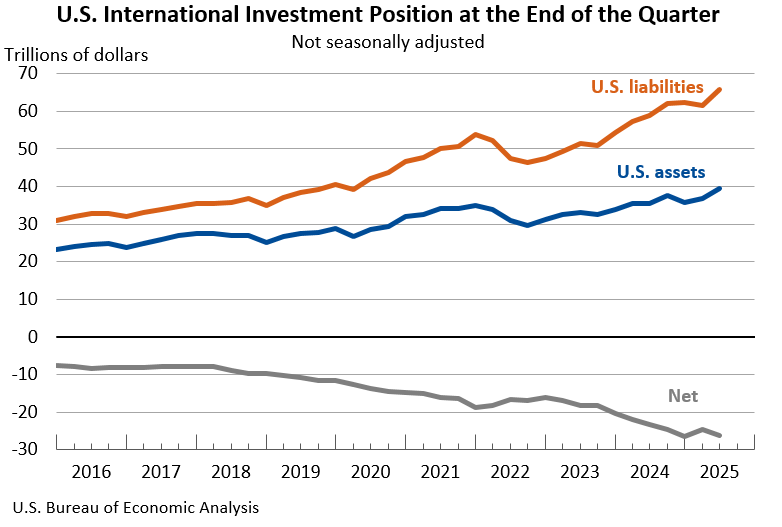Notice
Due to a lapse in appropriations, this website is not being updated.
Bureau of Economic Analysis
U.S. International Investment Position, 2nd Quarter 2025
The U.S. net international investment position, the difference between U.S. residents’ foreign financial assets and liabilities, was -$26.14 trillion at the end of the second quarter of 2025, according to statistics released today by the U.S. Bureau of Economic Analysis. Assets totaled $39.56 trillion, and liabilities were $65.71 trillion. At the end of the first quarter, the net investment position was -$24.65 trillion (revised).
Principal Federal Economic Indicators
Noteworthy
The Latest
Foreign Direct Investment by Country and Industry, 2016
Outward and Inward U.S. foreign direct investment continued to grow in 2016. The U.S. direct investment position abroad valued at historical cost grew 5.6 percent to $5,332.2 billion, compared with an average annual growth rate of 8.2 percent in 2006–2015. The foreign direct investment position in the United States valued at historical cost grew 12.8 percent to $3,725.4 billion, compared with an average annual growth rate of 6.7 percent in 2006–…
Gross Domestic Product by State, 4th quarter 2017 and annual 2017 (preliminary)
Real gross domestic product (GDP) increased in 47 states and the District of Columbia in the fourth quarter of 2017. The percent change in real GDP ranged from 5.2 percent in Texas to –1.3 percent in North Dakota.
March 2018 Trade Gap is $49.0 Billion
The U.S. monthly international trade deficit decreased in March 2018 according to the U.S. Bureau of Economic Analysis and the U.S. Census Bureau. The deficit decreased from $57.7 billion in February (revised) to $49.0 billion in March, as exports increased and imports decreased. The previously published February deficit was $57.6 billion. The goods deficit decreased $7.5 billion in March to $69.5 billion. The services surplus increased $1.3…
U.S. International Trade in Goods and Services, March 2018
The U.S. monthly international trade deficit decreased in March 2018 according to the U.S. Bureau of Economic Analysis and the U.S. Census Bureau. The deficit decreased from $57.7 billion in February(revised) to $49.0 billion in March,as exports increased and imports decreased. The previously published February deficit was $57.6 billion. The goods deficit decreased $7.5 billion in March to $69.5 billion. The services surplus increased $1.3…
Real Consumer Spending Increases in March
Personal income increased 0.3 percent in March, the same increase as in February. Wages and salaries, the largest component of personal income, increased 0.2 percent in March after increasing 0.4 percent in February.
Personal Income and Outlays, March 2018
Personal income increased $47.8 billion (0.3 percent) in March according to estimates released today by the Bureau of Economic Analysis. Disposable personal income (DPI) increased $39.8 billion (0.3 percent) and personal consumption expenditures (PCE) increased $61.7 billion (0.4 percent).
GDP Increases in First Quarter
Real gross domestic product (GDP) increased 2.3 percent in the first quarter of 2018, according to the "advance" estimate released by the Bureau of Economic Analysis. In the fourth quarter of 2017, real GDP increased 2.9 percent.
Gross Domestic Product, 1st quarter 2018 (advance estimate)
Real gross domestic product (GDP) increased 2.3 percent in the first quarter of 2018, according to the “advance” estimate released by the Bureau of Economic Analysis. In the fourth quarter of 2017, real GDP increased 2.9 percent.
Gross Domestic Product by Industry: Fourth Quarter 2017
Durable goods manufacturing; construction; and professional, scientific, and technical services were the leading contributors to the increase in U.S. economic growth in the fourth quarter of 2017. Overall, 16 of 22 industry groups contributed to the 2.9 percent increase in real GDP in the fourth quarter.
Gross Domestic Product by Industry, 4th quarter and annual 2017
Durable goods manufacturing; construction; and professional, scientific, and technical services were the leading contributors to the increase in U.S. economic growth in the fourth quarter of 2017. According to gross domestic product (GDP) by industry statistics released by the Bureau of Economic Analysis, 16 of 22 industry groups contributed to the overall 2.9 percent increase in real GDP in the fourth quarter.




